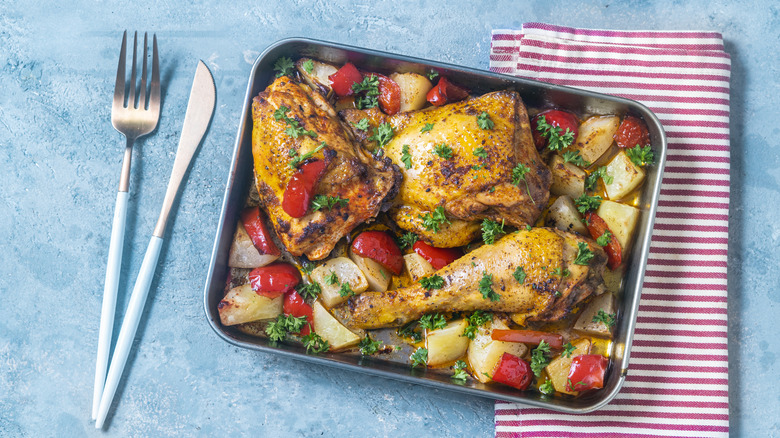Yes, Ina Garten Does Undercook Her Chicken On Purpose
If you bristle at the mention of undercooked chicken, you're not alone. Earlier this year, Ina Garten stoked controversy on her Instagram when she shared her fail-proof technique for making the perfect chicken breast – and yes, it involves slightly undercooking the chicken.
"When you overcook chicken, it gets very dry," explains Garten in her Instagram reel. To get perfectly juicy and flavorful chicken every time, she says she cooks the chicken with the skin on, undercooks it slightly and then lets it rest under a sheet of aluminum foil. The idea here is that the chicken continues to cook underneath the tin foil until it's ready to serve. She says this allows "all the juices to get back into the chicken," adding, "you won't believe what a difference this makes.
Garten says the trick to safely mastering this technique involves using a meat thermometer. She suggests removing your chicken from the oven when it's reached an internal temperature of 155 to 160 degrees Fahrenheit. She says, "It will keep cooking to 165 degrees as it rests under the foil, at which point it will still be hot and fully cooked."
From poaching to using a brine, there's no shortage of advice online for how to make succulent chicken and judging by the comments on the post not everyone is convinced that Garten's way is the answer. Several cited nerves over giving people food poisoning, with the top comment on the post was from Instagram user officially_mrs.reed, who said, "Undercook and chicken don't go in the same sentence for me ... I'll eat my chicken dry any day over that."
While you too, may also have doubts, resting your chicken can improve the flavor and consistency when done safely.
Why you should rest chicken
Chicken and other meats continue to cook after they've been removed from a heat source. It's why experts suggest removing your meat from the grill, cooktop or oven before it's reached its final temperature. As the meat rests, the internal temperature continues to increase, allowing the meat to reach the correct temperature while retaining moisture. The science is fairly simple. Meat is made of muscle fibers that hold water molecules when raw. However, when meat is cooked, these muscle fibers shrink and get firm, releasing these water molecules or natural juices. Instead of losing moisture onto the plate or cutting board, resting your chicken allows the natural juices to be reabsorbed back into the meat.
Generally speaking, the larger the cut, the longer it will need to rest to reach doneness. A chicken breast usually requires 5 to 10 minutes of resting time, whereas a full bird needs closer to 15 to 20 minutes. It's also important that you loosely cover it with tin-foil; this ensures that the heat goes into the meat (instead of the environment) while still providing some space for air circulation to prevent steaming the chicken's surface.
As mentioned above, if you're going to try this technique at home, you need to have a meat thermometer at your disposal so you can make sure that your chicken is fully cooked before serving. To prevent salmonella poisoning, Foodsafety.gov recommends that all poultry — whether that's a whole bird, breasts, thighs, wings or stuffing — be cooked to an internal temperature of 165 degrees Fahrenheit.

